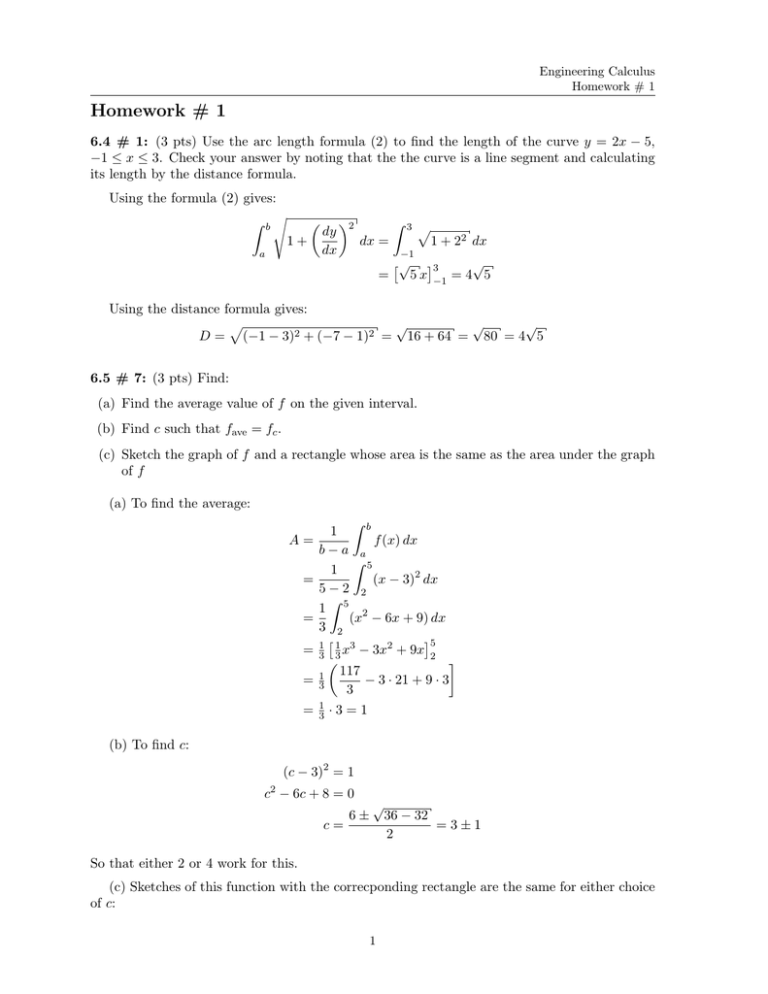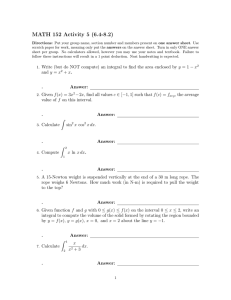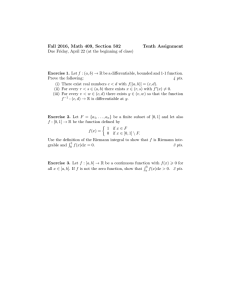Homework # 1
advertisement

Engineering Calculus Homework # 1 Homework # 1 6.4 # 1: (3 pts) Use the arc length formula (2) to find the length of the curve y = 2x − 5, −1 ≤ x ≤ 3. Check your answer by noting that the the curve is a line segment and calculating its length by the distance formula. Using the formula (2) gives: √ ∫ b ( 1+ a dy dx )2 ∫ 3 dx = √ 1 + 22 dx −1 = [√ √ ]3 5 x −1 = 4 5 Using the distance formula gives: √ √ √ √ D = (−1 − 3)2 + (−7 − 1)2 = 16 + 64 = 80 = 4 5 6.5 # 7: (3 pts) Find: (a) Find the average value of f on the given interval. (b) Find c such that fave = fc . (c) Sketch the graph of f and a rectangle whose area is the same as the area under the graph of f (a) To find the average: A= = = = = = ∫ b 1 f (x) dx b−a a ∫ 5 1 (x − 3)2 dx 5−2 2 ∫ 1 5 2 (x − 6x + 9) dx 3 2 [ ]5 2 1 1 3 3 3 x − 3x + 9x 2 ( ] 117 1 − 3 · 21 + 9 · 3 3 3 1 3 ·3=1 (b) To find c: (c − 3)2 = 1 c2 − 6c + 8 = 0 c= 6± √ 36 − 32 =3±1 2 So that either 2 or 4 work for this. (c) Sketches of this function with the correcponding rectangle are the same for either choice of c: 1 Engineering Calculus Homework # 1 With c = 2 With c = 4 y y 5 5 4 4 3 3 2 2 1 1 x 1 2 3 4 x 5 1 2 3 4 5 6.6 # 11: (4 pts) Show how to approximate the required work by a Riemann sum. Then express the work as an integral and evaluate it. A heavy rope, 50 feet long, weighs 0.5 lb/ft and hangs over the edge of a building 120 feet high. (a) How much work is done in pulling the rope to the top of the building? (b) How much work is done in pulling half the rope to the top of the building? Note that this is answered on the web page http://answers.yahoo.com/question/index?qid=20110305164332AAi but that that answer is not correct for lifting the rope half-way (it uses x for the remaining length of the rope rather than 50 − x, the second integral would need to have limits from 25 to 50). bf (a): When a length of rope xi has been pulled to the top of the building, then the force required to move the remaining rope is 12 g(50 − xi ), the weight of the rope. The work to pull an additional small length of rope, ∆x, to the top of the building is 12 (50 − xi )∆x. Note that the relationship between xi and ∆x is that for n constant lengths of rope equal to ∆x, then xi = i∆x. The Riemann sum for the work is: W = n ∑ 1 2 (50 − xi )∆x = 21 (50 − i∆x)∆x i=1 Note that xi = i∆x will not limit to zero as n → ∞. The corresponding integral is: ∫ 5 [ ]5 W = 0 12 (50 − x) dx = 12 50x − 12 x2 0 0 = 625ft lbs 0 bf (b): This requires almost the same Riemann sum except the upper limit on the sum changes: W = n/2 ∑ 1 2 (50 − xi )∆x = 21 (50 − i∆x)∆x i=1 2 Engineering Calculus Homework # 1 The corresponding integral is: ∫ 2 ]2 [ W = 5 12 (50 − x) dx = 12 50x − 21 x2 0 5 = 466.75ft lbs 0 6.6 # 34: (4 pts - removed) A vertical plate is suspended (or partially submerged) in water and has the indicated shape. Explain how to approximate the hydrostatic force against one side of the plate by a Riemann sum. Then express the force as an integral and evaluate it. Measure the depth of the plate in the water as x. Divide the plate into n horizontal strips below the water. A horizontal strip of the plate under the water at a depth of xi measured from the surface of the water. It has a height of ∆x and a width of 3 − xi . The Riemann sum for this is P = n ∑ 1000gxi (3 − xi )∆x n=1 The corresponding integral is ∫ 1 1000gx(3 − x) dx [ ]1 = 1000g 32 x2 − 13 x3 0 P = 0 = 1000g 76 ≈ 11445 ≈ 1.1 × 104 N ∫ 2 Note that the integral 1000g(x − 1)(4 − x) dx also works for this. 1 3





